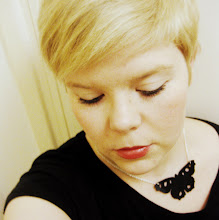Hulluuden määritteleminen kiinnostaa minua; se miten hieno raja ”hullujen” ja ”tavallisten” välillä joskus tuntuu olevan ja kuka lopulta saa päättää, ketkä kuuluvat millekin puolelle tuota rajaa. Samaa teemaa käsitellään ainakin Paulo Coelhon Veronika päättää kuolla -kirjassa. Myös Coelhon vanhemmat sulkivat poikansa mielisairaalaan useaan otteeseen vastoin tämän tahtoa; Coelho on myös ollut vahvasti vaikuttamassa tahdonvastaisen mielisairaanhoidon kieltävän lain syntymiseen Brasiliassa. Näin vastikään myös Shutter Island -elokuvan, jossa siinäkään ei ole ihan selvää, kuka lopulta on hullu tai oikeassa. Aihe mietityttää siis muitakin kuin minua, ehkä erityisesti taiteilijoita jotka usein tasapainoilevat siinä neron ja hullun rajalla.
Kirja sinänsä ei ollut mikään mestariteos eikä niin uskomattoman hauska kuin takakannessa mainostettiin. Ei se kyllä huonokaan ollut. Kieli oli helppoa, en kyllä tiedä onko kirjaa edes suomennettu. Kirjan ja elokuvan tarinat eivät kulje ihan käsi kädessä, mutta kirja ei silti antanut kovinkaan paljon uutta tietoa elämästä huippukalliissa mielisairaalassa 1960-luvulla. Kirjassa on enemmän Kaysenin omaa pohdintaa diagnoosistaan ja mielen sairastamisesta yleensä kuin elokuvassa. Hän kirjoittaa myös siitä, miten mielisairaus on yleensä koko perheen sairaus; ei välttämättä eikä pelkästään sen, joka suljetaan laitokseen. Vähän kuten alkoholismi tai muu ongelmakäyttäytyminen, joilla toki on usein yhteys mielenterveyden häiriöihin. (Pahoittelut, jos puhun hulluista tai mielisairaista holtittomasti, tarkoitukseni ei ole tuomita ketään tms., vaikken jaksakaan tässä miettiä kovin tarkkaan mikä termi on soveliain missäkin kohdassa.)
Ystäväni, joka lukee pelkästään ”hyviä kirjoja” moitti minua Girl, Interruptedin lukemisesta. Hänen mielestään on ajanhukkaa lukea kirja, jos on jo nähnyt sen pohjalta tehdyn elokuvan. Itse olen yleensä sitä mieltä, että kirja on aina parempi kuin elokuva, varsinkin jos kirja on ollut ensin. Luen myös mielelläni kirjan ennen elokuvan näkemistä. Nytkin näin koko ajan silmissäni Winonan ja Angelinan ja tällä kertää myös pidän elokuvasta enemmän kuin kirjasta. Jos on kiinnostunut hulluuden rajanvedoista, kirja on kyllä ihan kiinnostava. Pöydän kulmalla odottaakin jo Sylvia Plathin The Bell Jar – Plath oli hoidossa samassa mielisairaalassa kuin Kaysen.
"People ask, How did you get in there? What they really want to know is if they are likely to end up in there as well. I can't answer the real question. All I can tell them is, It's easy.
And it is easy to slip in a parallel universe. there are so many of them: worlds of the insane, the criminal, the cripled, the dying, perhaps of the dead as well. These worlds exist alongside this world and resemble it, but are not in it."

I love the movie Girl, Interrupted. I’ve always have and when I saw it the dozenth time some months ago, I started thinking that it might be nice to read the book the movie’s based on as well. The movie and the book tell a story about the youth experiences of the writer Susanna Kaysen. Her parents half-forced her into a mental institution for almost two years; her diagnosis was borderline personality.
I’m really interested in the ways we define madness. Often the line between “crazy” and “normal” people is very thin. Some people also have the privilege of deciding who goes on which side of that line. Paulo Coelho has also written about the same theme in his book Veronika decides to die. His parents also put him in an institution for several times and afterwards he was fighting hard for the law that forbids mental treatment against person’s own will. I also just saw the movie Shutter Island in which it’s also a bit vague who’s crazy and who’s right in the end. Guess I’m not the only one who’s fascinated about the subject. Maybe it’s more normal for artist who are often said to be balancing on the thin line between genius and madness.
The book wasn’t a masterpiece nor as triumphantly funny as they say in the cover. But it was okay. The storyline in the movie and in the book is not 100% the same but the book doesn’t really give that much new information about the life in a mental institution in the sixties. There’s a bit more Kaysen’s own thoughts about her diagnosis in it than in the movie though. She also writes how she thinks that mental disorder is often a disease of the whole family and not just theirs who’s locked up. A bit like alcoholism for ex. – which often also has connection to mental problems.
My friend who only reads “good books” said to me that it’s loss of time reading the book if you’ve already seen the movie. I usually think that the book is better and the movie and prefer reading the book before seeing the movie based on it. I did see Winona and Angelina in my eyes the whole time but this time I think the movie’s actually a lot better than the book. Still if you’re interested in the subject you might like the book. Sylvia Plath’s The Bell Jar is already waiting for me – she got treated at the same hospital as Kaysen.

No comments:
Post a Comment